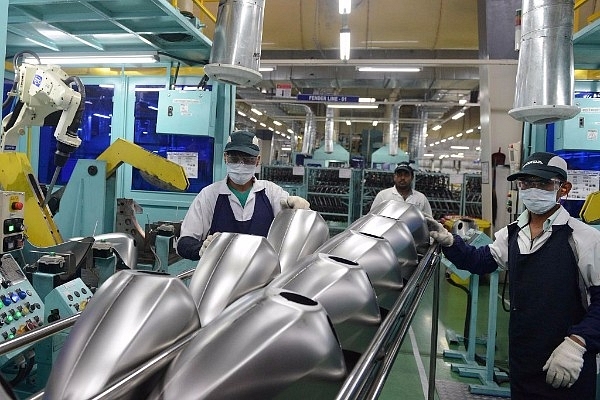Insta
3.2 Per Cent Rise In India’s Industrial Output In August

(SAM PANTHAKY/AFP/Getty Images)
According to official data released by the Ministry of Commerce and Industry on Friday (30 September), the select industrial output of India rose by 3.2 per cent in August 2016 on the back of higher production of steel, fertilisers and refinery products.
The index of Eight Core Industries (ECI) had increased by 3 per cent in July and had risen by 3.2 per cent in the corresponding month of 2015. The cumulative growth during April to August increased by 4.5 per cent. The index includes sectors like coal, crude oil, natural gas, refinery products, fertilisers, steel (alloy and non-alloy), cement and electricity.
The ECI makes up nearly 38 per cent weightage of the items included in the Index of Industrial Production (IIP). Electricity generation, which has the highest weightage of 10.32 per cent in the IIP, inched up by 0.1 per cent in August, as compared with the corresponding month of 2015.
Steel production, which is the second-most important component, surged the maximum among all the sub-indices. Distilling of refinery products, the third-most important component as per weightage, was higher by 3.5 per cent in August, as compared with the corresponding month of last year. However, extraction of crude oil, which has a 5.21 per cent weightage in IIP, decreased by 3.9 per cent during last month.
Coal mining, with a 4.38 per cent weightage, decreased by 9.2 per cent last month.Cement production, which has a weightage of 2.41 per cent, increased by 3.1 per cent in August 2016. On the other hand, the sub-index for natural gas output, with a weightage of 1.71 per cent declined by 5.7 per cent during the month under consideration. In contrast, fertiliser manufacturing, which has the least weightage of only 1.25 per cent rose by 5.7 per cent in August.
(With inputs from IANS)
Support Swarajya's 50 Ground Reports Project & Sponsor A Story
Every general election Swarajya does a 50 ground reports project.
Aimed only at serious readers and those who appreciate the nuances of political undercurrents, the project provides a sense of India's electoral landscape. As you know, these reports are produced after considerable investment of travel, time and effort on the ground.
This time too we've kicked off the project in style and have covered over 30 constituencies already. If you're someone who appreciates such work and have enjoyed our coverage please consider sponsoring a ground report for just Rs 2999 to Rs 19,999 - it goes a long way in helping us produce more quality reportage.
You can also back this project by becoming a subscriber for as little as Rs 999 - so do click on this links and choose a plan that suits you and back us.
Click below to contribute.
Latest